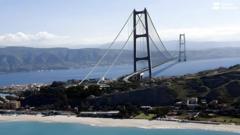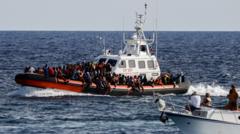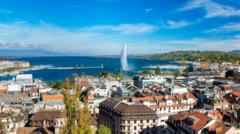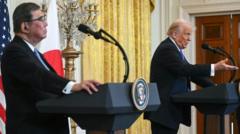**Rome's €13.5bn infrastructure project is poised to connect Sicily and Calabria, promising jobs but facing environmental scrutiny.**
**Italy Greenlights Ambitious 3.3km Suspension Bridge Project to Sicily**

**Italy Greenlights Ambitious 3.3km Suspension Bridge Project to Sicily**
**Final approval granted for the world's longest suspension bridge, igniting economic hopes despite local opposition.**
The Italian government has officially approved a groundbreaking €13.5 billion ($15.6 billion) project to construct the world's longest suspension bridge, spanning 3.3 kilometers (2.05 miles) across the Messina Strait. The ambitious endeavor aims to link Sicily with the Calabrian mainland at the southern tip of Italy.
Despite its challenges, including a history of stalled proposals due to concerns over costs, environmental impacts, and potential mafia influence, Prime Minister Giorgia Meloni praised the project as a vital investment for Italy's present and future. Advocate Meloni emphasized the importance of tackling "difficult challenges" that bring value to the nation.
The new bridge design is equipped to endure seismic activity due to its location in one of the Mediterranean's most earthquake-prone regions. The structure will feature two railway lines at its center and three lanes of traffic on either side. Transport Minister Matteo Salvini hailed the endeavor as a catalyst for economic growth, projecting the creation of approximately 120,000 jobs annually in the impoverished regions of Sicily and Calabria.
To finance the construction, Rome plans to classify the bridge's costs as military spending, which would contribute to meeting NATO defense spending targets of 5% of Italy's GDP. However, the project still requires final approvals from the Italian Court of Auditors and environmental agencies at both national and EU levels.
Local residents on both ends of the strait, whose properties may be affected, will also need to be consulted, providing a pathway for potential legal challenges that could delay or derail the project. Opponents, including local politicians and grassroots organizations, have voiced concerns over the bridge, describing it as "controversial and divisive." Critics argue it may divert funds from essential services like healthcare and school infrastructure, risking exacerbation of local issues rather than resolution.
The bridge's building plans date back over 50 years and have often been met with opposition, primarily due to worries about misuse of taxpayer money, especially in an area where mafia influence is prevalent. Local politicians have expressed disappointment over the swift government decision-making process, promoting a need for extended discussions. Furthermore, environmental activists highlight concerns about the bridge's potential demands on water resources in drought-stricken regions. For now, trains continue to rely on ferries for the 30-minute journey across the Strait.
Despite its challenges, including a history of stalled proposals due to concerns over costs, environmental impacts, and potential mafia influence, Prime Minister Giorgia Meloni praised the project as a vital investment for Italy's present and future. Advocate Meloni emphasized the importance of tackling "difficult challenges" that bring value to the nation.
The new bridge design is equipped to endure seismic activity due to its location in one of the Mediterranean's most earthquake-prone regions. The structure will feature two railway lines at its center and three lanes of traffic on either side. Transport Minister Matteo Salvini hailed the endeavor as a catalyst for economic growth, projecting the creation of approximately 120,000 jobs annually in the impoverished regions of Sicily and Calabria.
To finance the construction, Rome plans to classify the bridge's costs as military spending, which would contribute to meeting NATO defense spending targets of 5% of Italy's GDP. However, the project still requires final approvals from the Italian Court of Auditors and environmental agencies at both national and EU levels.
Local residents on both ends of the strait, whose properties may be affected, will also need to be consulted, providing a pathway for potential legal challenges that could delay or derail the project. Opponents, including local politicians and grassroots organizations, have voiced concerns over the bridge, describing it as "controversial and divisive." Critics argue it may divert funds from essential services like healthcare and school infrastructure, risking exacerbation of local issues rather than resolution.
The bridge's building plans date back over 50 years and have often been met with opposition, primarily due to worries about misuse of taxpayer money, especially in an area where mafia influence is prevalent. Local politicians have expressed disappointment over the swift government decision-making process, promoting a need for extended discussions. Furthermore, environmental activists highlight concerns about the bridge's potential demands on water resources in drought-stricken regions. For now, trains continue to rely on ferries for the 30-minute journey across the Strait.




















